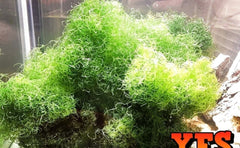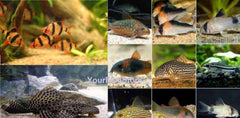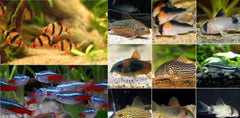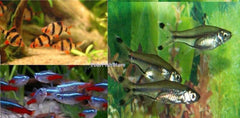X10 PANDA PLATY LIVE FISH PACKAGE - FREE SHIP - BULK SAVE
Ebay
$ 113.53

PLATY CARE GUIDE
Platy (xiphophorus) is a very popular tropical freshwater fish species held by aquarists around the world. They are extremely beautiful, small fish and come in every single color imaginable. Part of their popularity is due to the very low experience needed to keep them. Males grow to about 1.5 inches and females, being a little bigger, can grow up to 2.5 inches. Platies are native to both Central America and North America. There are numerous types of platies, but all are hybrids of two species heavily interbred in order to reach their full potential. The two most common species are Southern platy (Xiphophorus maculatus) and Variatus platy (Xiphophorus variatus).
As most other species from the Poeciliidae family, platies are great fish for both beginners and experienced aquarists. They are easy to keep and breed and their potential is great.
Tank size
Although platies are very small, they are an extremely active species. They love being in groups, but they are not a schooling fish. A ten-gallon aquarium should be just enough for a group of 5 adult platies. Having more than five fish in a ten-gallon tank is not recommended. When it comes to male and female ratio, the best thing you can do is to keep a group with one male and at least three females. This will help in reducing stress females are often exposed to.
Water conditions
Platies prefer water temperatures in the range from 70-77⁰ Fahrenheit. They are tolerant to temperature and water fluctuations, but take care for sudden changes in water parameters. These types of changes can lead to stress and should be avoided.
Platies are tolerant to a wide range of water conditions. The water hardness should be anywhere between 10–28 dGH. As for the water pH, platies thrive in slightly alkaline water, ideally in range from 6.8 to 8.0.
If you want your platies to thrive, you should definitely pay attention to water filtration. The filtering system should be able to keep the water in great condition and get rid of waste or excess food that will harm the water quality. Experts point out that great water conditions are particularly important for Swordtail platies, as they are more vulnerable to poor water conditions than other variations.
Feeding
Platies are considered omnivorous, but they have a substantial need for herbivorous food. One common mistake aquarists make is not adding enough algae or other vegetation for the platies. An ideal diet should be a healthy mix of both proteins and vegetables. Flakes and other prepared fish food are great for them as long as they are high in protein.
As far as live food is considered, they enjoy bloodworms, daphnia, brine shrimp, mosquito larvae, or fruit flies. If you can’t afford live food or it is not readily available, equivalent frozen foods should be just as good for your platies.
Tank mates
In general, platies are peaceful and active. They are by no means aggressive, so they should be great tank mates with other species. Fights between platy males happen from time to time, but the risk of injury isn’t very high in most cases. Platies are most commonly kept in community aquariums with other small size fish and close relatives. They get along very well with guppies, mollies, and some types of tetras. Some corydoras and characins in general are also great tank mates for platies.
BREEDING
Platies are live-bearing fish, like most of their close tropical freshwater relatives.A convenient factor for beginners is the platies ability to breed without a lot attention from the aquarist. They will breed very often and with a lot of fry. As experienced aquarists like to say, “Getting platies to breed isn’t difficult. Stopping them from breeding definitely is.” Given their ability to breed very fast and very efficiently, you can find yourself with more platies than you need in no time.If you care for them properly, the only thing you should worry about is overpopulation.
The pregnant female platy is easily identified with a huge belly and a dark gravid spot near the anal fin.
Once the fry are born they will freely swim around in search for food; however, the potential aggressor of the fry (even parents are known to eat them) should be removed from the tank. Planted tanks can only protect the fry for so long before they are eaten. While plants may help in the short term, removing one of the two is definitely a superior solution.
QUESTIONS & ANSWERS
Have a Question?
Be the first to ask a question about this.














